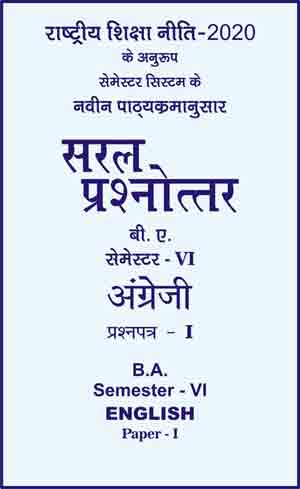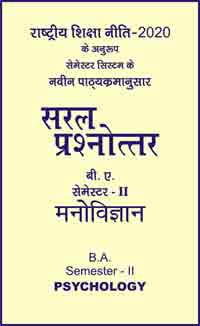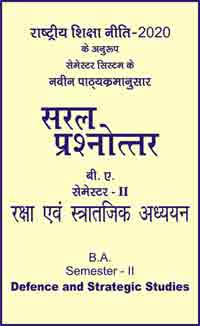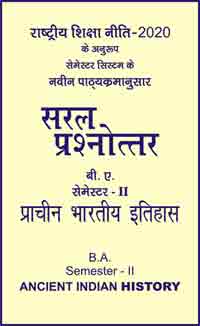|
बी ए - एम ए >> बीए सेमेस्टर 6 अंग्रेजी पेपर 1 बीए सेमेस्टर 6 अंग्रेजी पेपर 1सरल प्रश्नोत्तर समूह
|
5 पाठक हैं |
||||||
बीए सेमेस्टर 6 अंग्रेजी पेपर 1
Chapter 16 - Judith Wright: The Company of Lovers
Objective Type Questions
For each of the following questions, four alternatives are given for the answer. Only one of them is correct. Choose the correct alternative.
-
What is the central theme of "The Company of Lovers" by Judith Wright?
(a) Industrialization
(b) Nature and love
(c) War and conflict
(d) Political revolution -
In the poem, what does the "company of lovers" refer to?
(a) A group of friends
(b) Romantic couples
(c) Soldiers in a war
(d) Environmental activists -
Which of the following best describes the tone of "The Company of Lovers"?
(a) Optimistic
(b) Melancholic
(c) Humorous
(d) Suspenseful -
In which country was Judith Wright born?
(a) England
(b) Australia
(c) United States
(d) Canada -
Which year was Judith Wright born?
(a) 1915
(b) 1925
(c) 1935
(d) 1945 -
What was Judith Wright's primary literary focus?
(a) Novels
(b) Short stories
(c) Poetry
(d) Plays -
Which of the following is NOT a work by Judith Wright?
(a) "The Company of Lovers"
(b) "Woman to Man"
(c) "The Handmaid's Tale"
(d) "Blocky" -
Judith Wright was known for her activism in which area?
(a) Environmental conservation
(b) Civil rights
(c) Space exploration
(d) Technology advancement -
What literary award did Judith Wright receive for her poetry?
(a) Nobel Prize in Literature
(b) Pulitzer Prize for Poetry
(c) Man Booker Prize
(d) Queen's Gold Medal for Poetry -
What is a recurring theme in Judith Wright's poetry?
(a) Technology
(b) Nature and environment
(c) Political intrigue
(d) Supernatural elements -
Which of Judith Wright's poems addresses the relationship between humans and the natural world?
(a) "Blocky"
(b) "Woman to Man"
(c) "The Company of Lovers"
(d) "The Custodian" -
The poem is set in:
(a) A bustling city
(b) A lonely outback landscape
(c) A lush, tropical rainforest
(d) A historical battlefield -
The speaker describes the lovers as:
(a) Young and rebellious
(b) Middle-aged and contented
(c) Ancient and mysterious
(d) Fragile and ephemeral -
The poem can be interpreted as a meditation on:
(a) The destructive power of love
(b) The fleeting nature of human existence
(c) The beauty of the natural world
(d) The importance of social connection -
The tone of the poem is predominantly:
(a) Joyful and celebratory
(b) Melancholic and reflective
(c) Angry and indignant
(d) Erotic and passionate -
The final line, "And love, that holds them whole," suggests:
(a) The resilience of the human spirit
(b) The inevitability of loss and separation
(c) The transformative power of nature
(d) The ultimate triumph of love over death -
Which element of the poem is NOT explicitly mentioned?
(a) Fire
(b) Water
(c) Wind
(d) Metal -
"The Company of Lovers" can be linked to which of Judith Wright's other themes?
(a) Environmentalism
(b) Indigenous rights
(c) Urbanization and alienation
(d) Feminist concerns -
The poem opens with the speaker addressing:
(a) A specific lover
(b) A group of friends
(c) An unknown audience
(d) Herself -
The "Company of Lovers" in the title refers to:
(a) A literal group of people in a relationship
(b) A metaphorical connection with nature
(c) A spiritual or emotional union
(d) All of the above -
The line "Beyond the last inhabited wall" suggests:
(a) A physical boundary
(b) A social or cultural barrier
(c) The limitations of human understanding
(d) All of the above -
The image of the "green snake" can be interpreted as:
(a) A symbol of danger and temptation
(b) A representation of nature's power
(c) A reminder of mortality
(d) All of the above -
The speaker describes her experience with the "company of lovers" as:
(a) Joyful and carefree
(b) Challenging and transformative
(c) Painful and isolating
(d) A mixture of all these emotions -
A major theme of the poem is:
(a) The power of romantic love
(b) The interconnectedness of all living things
(c) The human search for meaning
(d) All of the above -
"The Company of Lovers" can be considered an example of:
(a) Romantic poetry
(b) Nature poetry
(c) Spiritual poetry
(d) A combination of all these genres -
What is the main theme of the poem?
(a) Nature
(b) Love and Death
(c) War
(d) Friendship -
How many stanzas are in the poem?
(a) One
(b) Two
(c) Three
(d) Four -
What does the phrase “the lost company” refer to?
(a) A group of soldiers
(b) Lovers
(c) Forgotten friends
(d) Travelers -
What is the significance of “the night” in the poem?
(a) Fear
(b) Separation
(c) Intimacy and connection
(d) Darkness -
What do lovers throw away for love, according to the poem?
(a) Money
(b) Other relationships
(c) Everything else
(d) Their fears -
The ‘narrow grave’ in the poem symbolizes what?
(a) Poverty
(b) Confinement
(c) Death
(d) Loneliness -
What does the phrase “we meet and part now” suggest about relationships?
(a) They are long-lasting
(b) They are unstable
(c) They are quickly formed and ended
(d) They are unimportant -
Who is the author of “The Company Of Lovers”?
(a) Sylvia Plath
(b) Judith Wright
(c) Emily Dickinson
(d) William Blake -
What literary device is prominent in “We meet and part now”?
(a) Metaphor
(b) Simile
(c) Paradox
(d) Hyperbole -
In the poem, what counters the happiness of lovers?
(a) Society
(b) Distance
(c) Death
(d) Misunderstanding -
What does ‘locking hands’ symbolize in the poem?
(a) Agreement
(b) Strength
(c) Unity in love
(d) Protection -
What emotion is evoked by “chilling heart”?
(a) Excitement
(b) Fear
(c) Joy
(d) Coldness -
The poem was written in which year?
(a) 1920
(b) 1946
(c) 1955
(d) 1960 -
What does ‘grope in the night’ suggest?
(a) Searching for something
(b) Fear of the dark
(c) Physical intimacy
(d) Confusion -
The phrase “preludes of the drums” likely symbolizes?
(a) Musical performance
(b) Approaching danger
(c) Celebrations
(d) Heartbeats -
"Death draws his cordons in" suggests what?
(a) Imprisonment
(b) Protection
(c) Inevitability of death
(d) A battle -
What does ‘the night’ primarily symbolize in the poem?
(a) Danger
(b) Love
(c) Death
(d) Mystery -
The overall mood of the poem is?
(a) Joyful
(b) Romantic
(c) Melancholic
(d) Anxious -
"The Company Of Lovers" can be categorized as a poem of?
(a) War
(b) Love
(c) Nature
(d) Fantasy -
The use of ‘silently’ at the end of the first stanza emphasizes?
(a) Secrecy
(b) Reflection
(c) Sorrow
(d) Peace -
In the poem, love is portrayed as?
(a) Destructive
(b) Eternal
(c) Transient
(d) Unrequited -
The poem’s setting can be described as?
(a) Urban
(b) Rural
(c) Undefined
(d) Historical -
The imagery in the poem is mainly focused on?
(a) Nature
(b) Physical beauty
(c) Emotional states
(d) Historical events -
What is the effect of the poem’s paradoxical language?
(a) Confusion
(b) Emphasis on complexity
(c) Humor
(d) Simplification -
The poem’s structure (two stanzas) aids in contrasting?
(a) Past and present
(b) Love and hate
(c) Youth and old age
(d) Love and death -
Australian Poet Judith Wright is known for her … … … work.
(a) Excavation
(b) Environmental
(c) Diplomatic
(d) Missionary -
What was the full name of Judith Wright?
(a) Judith Arundell Wright
(b) Judith Aruna Wright
(c) Judith Arundhati Wright
(d) Judith Aruwali Wright -
Judith Wright was died in -
(a) 25 May, 2000
(b) 25 June, 2000
(c) 30 August 1999
(d) 30 September, 2000 -
Who is the poet of 'Company of Lovers'?
(a) Nivedita Menon
(b) William Blake
(c) Judith Wright
(d) T.S Eliot -
The Poem 'The Company of Lovers' is written in -
(a) 1946
(b) 1950
(c) 1940
(d) 1942 -
When did Judith Wright start writing poetry?
(a) At the age of six
(b) At the age of eight
(c) At the age of ten
(d) At the age of twelve -
Who was the recipient of the Christopher Brennan Award?
(a) Nivedita Menon
(b) Judith Wright
(c) Mahesh Dattani
(d) T.S. Eliot -
Where was Judith born?
(a) Armidale, New South Wales, Australia
(b) Avon, Warwickshire, England
(c) Europe
(d) Nepal -
What is the name of spouse of Judith Wright?
(a) Jack Mckinney
(b) Patrick Write
(c) William Blakes
(d) William Wordsworth -
Judith won Queen's Gold Medal for Poetry in -
(a) 1991
(b) 1989
(c) 1990
(d) 1981 -
Judith received Australian National Living Treasure Award in -
(a) 1990
(b) 1998
(c) 1980
(d) 1981 -
"We meet and part now over all the world; We, the lost ... ... ..." complete it with word.
(a) Friend
(b) Company
(c) Fellow
(d) Soldiers -
"... ... ... Marshalls up his armies round us now" it with accurate word.
(a) Life
(b) Battle
(c) Death
(d) Enemies
|
|||||













